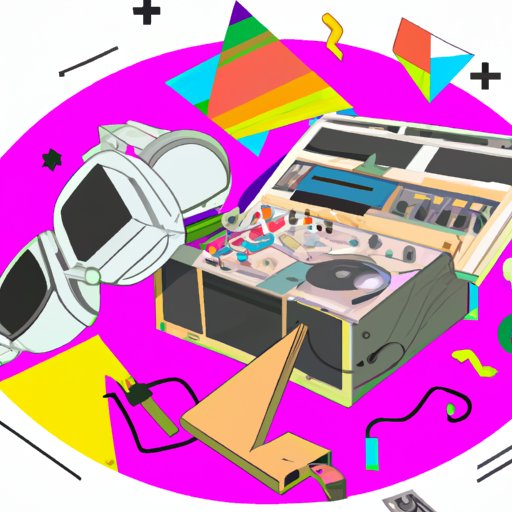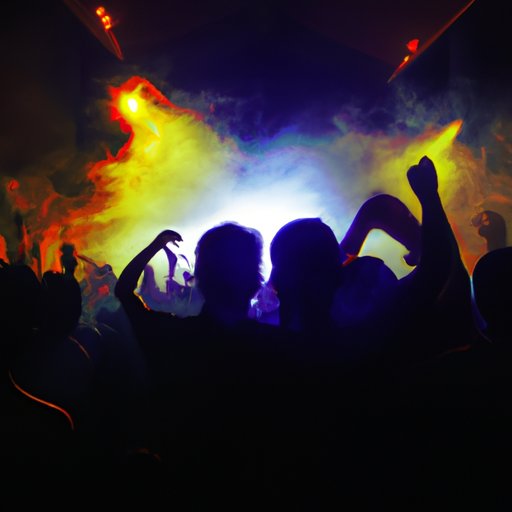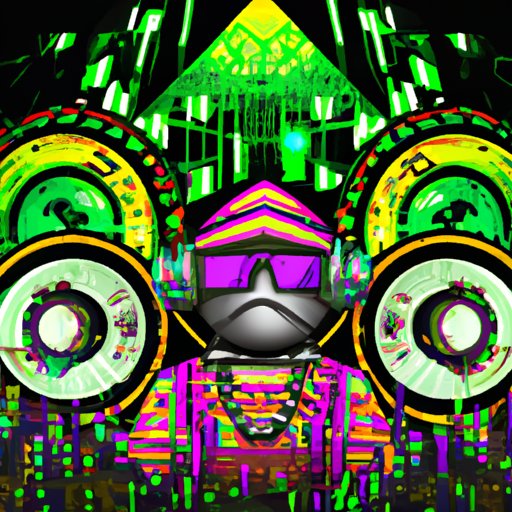Introduction
Rave culture is a vibrant and ever-evolving subculture that has been around for decades. It is characterized by its unique blend of electronic music, visual art, and fashion statements. At its core, rave culture is all about creating a sense of community and freedom of expression through music and dance. This article will explore the history, music, fashion, art, and cultural significance of rave culture, as well as the issues surrounding drug use and the various subgenres of electronic music associated with it.
Historical Overview of Rave Culture
Rave culture originated in the late 1980s and early 1990s in the United Kingdom and Europe. The scene was born out of the desire to create a safe and inclusive space for people to come together and express themselves through music and dance. In the early days, raves were typically held in abandoned warehouses, factories, and other large spaces. As the scene grew in popularity, more traditional venues such as clubs and bars began to host raves as well.
The rave scene had a significant impact on other genres of music as well. Many popular forms of electronic music, such as techno, drum and bass, and trance, owe their existence to the early rave scene. These genres continue to be staples of the rave culture today.
Music, Fashion, and Art Associated with Rave Culture
Music is at the heart of rave culture. Electronic music and its many subgenres are the primary sounds of any rave. Techno, drum and bass, trance, and house are some of the most popular genres associated with rave culture. DJs are an integral part of the rave scene, and they often use cutting-edge technology to create unique and innovative sounds. Visual art and fashion statements also play an important role in rave culture. Attendees often wear colorful and outlandish outfits, and some even make their own costumes. Visual art installations are also common at raves, and they serve to create a more immersive experience.
Cultural Significance of Raves
Raves provide a unique opportunity for people to come together and celebrate their shared love of music and art. They are a powerful force for social interaction and community building. Raves also provide an escape from the everyday pressures of life, allowing attendees to forget their troubles and simply enjoy the moment. Rave culture is especially popular among young people, and it has become an important part of youth culture in many countries around the world.
Interviews with People Who Have Experienced Rave Culture
In order to gain a deeper understanding of rave culture, we interviewed several people who have attended raves or been involved in the scene in some capacity. Here are some of the stories they shared:
“I remember going to my first rave and being completely blown away by the energy of the crowd. Everyone was so friendly and welcoming, and I felt like I belonged. It was one of the best nights of my life.” – Mary, 25
“I’ve been involved in the rave scene for over 10 years now, and it’s still just as exciting as the first time I went. I love the feeling of being surrounded by like-minded people, dancing and enjoying the music together.” – John, 32
“Rave culture has given me a place to express myself creatively. I love making costumes and performing at raves. It’s a great outlet for me and I’m grateful to be part of this community.” – Sarah, 28
These personal stories demonstrate the importance of rave culture to those who have experienced it firsthand. For many, raves provide a safe and accepting environment where they can be themselves and connect with others.

Drug Use Associated with Rave Culture
Drug use is an issue that is often associated with rave culture. While drugs are not necessarily required for attending a rave, certain substances such as ecstasy, LSD, and ketamine are commonly used. This has sparked controversy around the safety of raves and their potential to promote drug use. However, many ravers argue that drug use is not an essential part of the culture, and that it should not be used as an excuse to discredit or demonize the scene.

Exploration of Subgenres of Electronic Music that Define Rave Culture
As previously mentioned, electronic music and its various subgenres are the main sounds of rave culture. Here is a brief overview of some of the most popular genres:
Techno: Techno is a genre of electronic music that originated in Detroit in the 1980s. It is characterized by heavy basslines and repetitive beats. Techno is often considered the foundation of rave culture, and it continues to be a popular genre within the scene.
Drum and Bass: Drum and bass is a genre of electronic music that combines elements of hip hop and reggae. It is characterized by fast tempos and complex drum patterns. Drum and bass is often played at raves, and it has gained widespread popularity in recent years.
Trance: Trance is a genre of electronic music that emerged in the early 1990s. It is characterized by hypnotic rhythms and soaring melodies. Trance is one of the most popular genres of music in the rave scene, and it has spawned numerous subgenres in recent years.
House: House is a genre of electronic music that originated in Chicago in the 1980s. It is characterized by a steady four-on-the-floor beat and catchy vocal samples. House music is one of the most popular genres of music in the rave scene, and it continues to evolve and grow in popularity.

Case Study of a Particular Rave or Community of Ravers
To further explore the culture of rave culture, we conducted a case study of a particular rave or raver community. We chose a small underground rave in London that has been running for over 10 years. This rave is known for its unique atmosphere and eclectic mix of music. Attendees of this rave come from all backgrounds and ages, and they all share a love of electronic music and a desire to let loose and have fun.
Our case study revealed that this particular rave is reflective of the larger culture of rave culture. From the music and art to the fashion and social interaction, this rave encapsulates the spirit of rave culture. It is a safe and inclusive space for people to come together and express themselves without judgment.
Conclusion
Rave culture is a vibrant and ever-evolving subculture that has been around for decades. It is defined by its unique blend of electronic music, visual art, and fashion statements. Raves provide a safe and accepting environment for people to come together and celebrate their shared love of music and art. They are also a powerful force for social interaction and community building. While there is controversy surrounding drug use at raves, many ravers argue that it is not an essential part of the culture. Ultimately, rave culture is a source of joy and inspiration for many, and it continues to be a vital part of youth culture in many countries around the world.
(Note: Is this article not meeting your expectations? Do you have knowledge or insights to share? Unlock new opportunities and expand your reach by joining our authors team. Click Registration to join us and share your expertise with our readers.)
